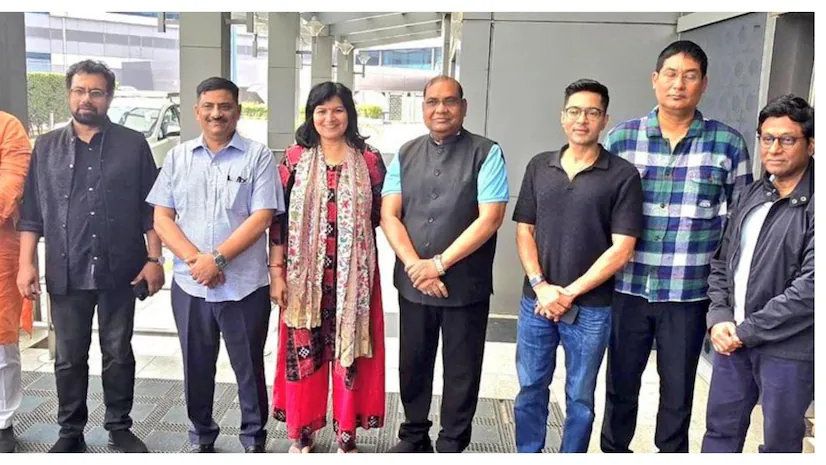Recent Posts
India Launches Operation Sindoor, Targets Pak Terror Links


Introduction
In a decisive move against cross-border terrorism, India launched Operation Sindoor on May 7, 2025. This operation was a direct response to the Pahalgam terror attack on April 22, 2025, which claimed 26 lives, including that of a Nepali national . The Indian Armed Forces targeted nine terror camps in Pakistan and Pakistan-occupied Kashmir (PoK), aiming to dismantle the infrastructure supporting terrorist activities against India .
Background: The Pahalgam Terror Attack
The Pahalgam attack was marked by extreme brutality, with victims shot at close range in front of their families. Foreign Secretary Vikram Misri described it as the deadliest civilian attack since the 2008 Mumbai attacks . The attack aimed to incite communal tensions and disrupt peace in Jammu and Kashmir.
Objectives of Operation Sindoor
Operation Sindoor was meticulously planned with the following objectives:
- Neutralize Terror Infrastructure: Dismantle camps operated by groups like Jaish-e-Mohammed (JeM), Lashkar-e-Taiba (LeT), and Hizbul Mujahideen.
- Eliminate Key Operatives: Target mid- to high-ranking field commanders responsible for orchestrating attacks in India .
- Minimize Civilian Casualties: Conduct precision strikes to avoid harm to civilians, showcasing India’s commitment to ethical military conduct.
Execution of the Operation
The Indian Armed Forces executed 24 missile strikes across nine locations in Pakistan and PoK. These strikes were carried out with surgical precision, avoiding civilian areas and focusing solely on terrorist infrastructure . The operation was coordinated among the Army, Navy, and Air Force, demonstrating India’s integrated defense capabilities.
Targets and Their Significance
The operation targeted nine significant terror camps:
- Markaz Subhan Allah, Bahawalpur: JeM’s headquarters, associated with Masood Azhar, and linked to several attacks including Pulwama .
- Markaz Taiba, Muridke: LeT’s base, where 26/11 attacker Ajmal Kasab was trained .
- Sarjal Camp, Sialkot: JeM facility linked to the 2016 Pathankot attack .
- Mehmoona Joya Camp, Sialkot: Hizbul Mujahideen’s center, involved in reviving terrorism in Jammu region .
- Shawai Nalla Camp, Muzaffarabad: LeT training center for terrorists involved in attacks in Sonmarg and Gulmarg .
- Syedna Bilal Camp, Muzaffarabad: JeM’s launchpad, providing training in arms and jungle survival .
- Gulpur Camp, Kotli: LeT base linked to attacks in Poonch and the killing of pilgrims in Reasi .
- Abbas Camp, Kotli: LeT’s suicide bomber training center .
- Barnala Camp, Bhimber: Facility for training in weapons handling and IEDs .
Outcomes of the Operation
The operation resulted in the elimination of approximately 70 terrorists, including key commanders . The precision of the strikes minimized civilian casualties, and the operation was lauded for its strategic execution. Defense Minister Rajnath Singh praised the forces for their surgical precision and emphasized India’s commitment to combating terrorism .
Pakistan’s Response
Pakistan’s military warned India against further aggression, accusing it of violating the ceasefire and engaging in transnational killings . The situation has escalated tensions between the two nuclear-armed neighbors.
India’s Continued Vigilance
Indian intelligence agencies have intensified surveillance to uncover any terror-support cells operating within the country . The Line of Control has been fortified with T-72 tanks to prevent infiltration attempts . Operation Sindoor is ongoing, with the Indian Army prepared for further action if necessary .
Educational Initiatives
In a move to educate the younger generation about the nation’s efforts against terrorism, the Uttarakhand Madrassa Education Council has proposed integrating a chapter on Operation Sindoor into the madrassa curriculum .
Recent Posts
Categories
- Actor4
- Actress7
- Bank4
- Biography2
- Bollywood4
- Business10
- Company9
- cricket4
- Economy23
- Education6
- Entertainment47
- External Affairs Defence Security1
- Finance1
- Football1
- Health1
- Hollywood2
- Home1
- India70
- india9
- Industry6
- Latest News53
- lifestyle1
- maharashtra1
- market4
- Politicians13
- Politics29
- Press Release282
- Social8
- Sports28
- Stock Marekt18
- Technology24
- Tollywood2
- World40
- world17
Related Articles
“Rajnath Singh Says Modi to Stay BJP’s PM Candidate for Future”
Strong Statement on India’s Political Future Defence Minister Rajnath Singh has sent...
ByNewsium DeskSeptember 24, 2025Rahul Gandhi Accuses CEC of Shielding Democracy Destroyers
Rahul Gandhi Accuses CEC of Shielding Those Who ‘Destroyed Democracy’ Congress leader...
ByNewsium DeskSeptember 18, 2025Rohan Jaitley Responds to Rahul Gandhi’s Remark on Father
Rohan Jaitley Responds to Rahul Gandhi’s Remark on Father Arun Jaitley: A...
ByNewsium DeskAugust 2, 2025Trump Repeated India-Pak Ceasefire Claim: Ramesh
Introduction In a striking political critique, senior Congress leader Jairam Ramesh recently...
ByNewsium DeskJuly 15, 2025













Leave a comment